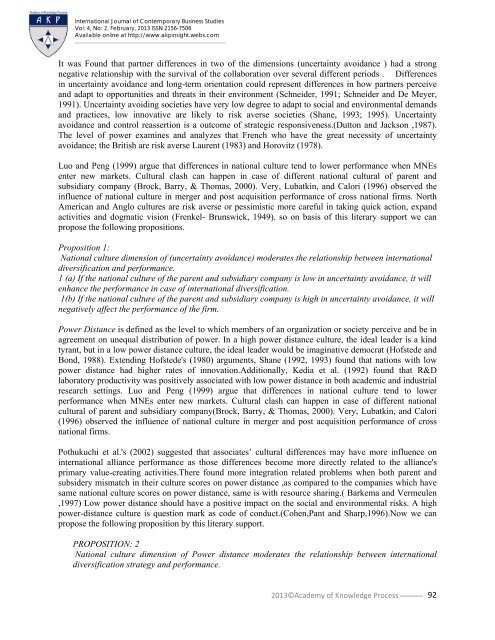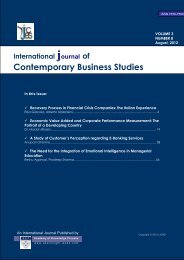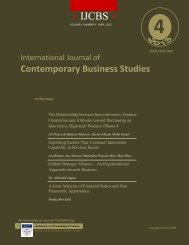Contemporary Business Studies - Academy of Knowledge Process ...
Contemporary Business Studies - Academy of Knowledge Process ...
Contemporary Business Studies - Academy of Knowledge Process ...
You also want an ePaper? Increase the reach of your titles
YUMPU automatically turns print PDFs into web optimized ePapers that Google loves.
International Journal <strong>of</strong> <strong>Contemporary</strong> <strong>Business</strong> <strong>Studies</strong>Vol: 4, No: 2. February, 2013 ISSN 2156-7506Available online at http://www.akpinsight.webs.comIt was Found that partner differences in two <strong>of</strong> the dimensions (uncertainty avoidance ) had a strongnegative relationship with the survival <strong>of</strong> the collaboration over several different periods . Differencesin uncertainty avoidance and long-term orientation could represent differences in how partners perceiveand adapt to opportunities and threats in their environment (Schneider, 1991; Schneider and De Meyer,1991). Uncertainty avoiding societies have very low degree to adapt to social and environmental demandsand practices, low innovative are likely to risk averse societies (Shane, 1993; 1995). Uncertaintyavoidance and control reassertion is a outcome <strong>of</strong> strategic responsiveness.(Dutton and Jackson ,1987).The level <strong>of</strong> power examines and analyzes that French who have the great necessity <strong>of</strong> uncertaintyavoidance; the British are risk averse Laurent (1983) and Horovitz (1978).Luo and Peng (1999) argue that differences in national culture tend to lower performance when MNEsenter new markets. Cultural clash can happen in case <strong>of</strong> different national cultural <strong>of</strong> parent andsubsidiary company (Brock, Barry, & Thomas, 2000). Very, Lubatkin, and Calori (1996) observed theinfluence <strong>of</strong> national culture in merger and post acquisition performance <strong>of</strong> cross national firms. NorthAmerican and Anglo cultures are risk averse or pessimistic more careful in taking quick action, expandactivities and dogmatic vision (Frenkel- Brunswick, 1949). so on basis <strong>of</strong> this literary support we canpropose the following propositions.Proposition 1:National culture dimension <strong>of</strong> (uncertainty avoidance) moderates the relationship between internationaldiversification and performance.1 (a) If the national culture <strong>of</strong> the parent and subsidiary company is low in uncertainty avoidance, it willenhance the performance in case <strong>of</strong> international diversification.1(b) If the national culture <strong>of</strong> the parent and subsidiary company is high in uncertainty avoidance, it willnegatively affect the performance <strong>of</strong> the firm.Power Distance is defined as the level to which members <strong>of</strong> an organization or society perceive and be inagreement on unequal distribution <strong>of</strong> power. In a high power distance culture, the ideal leader is a kindtyrant, but in a low power distance culture, the ideal leader would be imaginative democrat (H<strong>of</strong>stede andBond, 1988). Extending H<strong>of</strong>stede's (1980) arguments, Shane (1992, 1993) found that nations with lowpower distance had higher rates <strong>of</strong> innovation.Additionally, Kedia et al. (1992) found that R&Dlaboratory productivity was positively associated with low power distance in both academic and industrialresearch settings. Luo and Peng (1999) argue that differences in national culture tend to lowerperformance when MNEs enter new markets. Cultural clash can happen in case <strong>of</strong> different nationalcultural <strong>of</strong> parent and subsidiary company(Brock, Barry, & Thomas, 2000). Very, Lubatkin, and Calori(1996) observed the influence <strong>of</strong> national culture in merger and post acquisition performance <strong>of</strong> crossnational firms.Pothukuchi et al.'s (2002) suggested that associates’ cultural differences may have more influence oninternational alliance performance as those differences become more directly related to the alliance'sprimary value-creating activities.There found more integration related problems when both parent andsubsidery mismatch in their culture scores on power distance ,as compared to the companies which havesame national culture scores on power distance, same is with resource sharing.( Barkema and Vermeulen,1997) Low power distance should have a positive impact on the social and environmental risks. A highpower-distance culture is question mark as code <strong>of</strong> conduct.(Cohen,Pant and Sharp,1996).Now we canpropose the following proposition by this literary support.PROPOSITION: 2National culture dimension <strong>of</strong> Power distance moderates the relationship between internationaldiversification strategy and performance.2013©<strong>Academy</strong> <strong>of</strong> <strong>Knowledge</strong> <strong>Process</strong>92
















